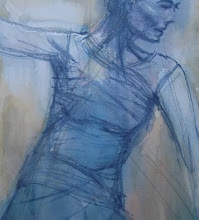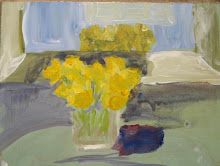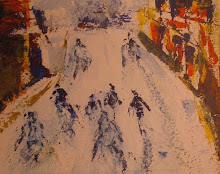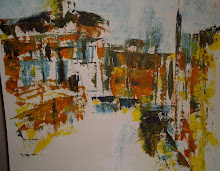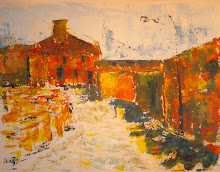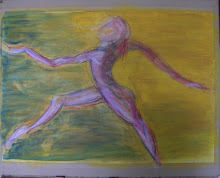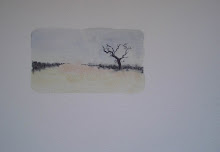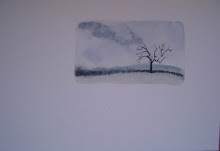Sometimes when I'm drawing or painting I create, usually without intention, a line or shape or tone that stops me and shocks me. There is something suddenly so beautiful that I feel almost breathless and kind of scared by what has happened. Do other artists experience this?
Having stopped, it feels risky to restart because what produced the awe will disappear as soon as I make another mark. Inevitably I do start again and lose it. Perhaps I should stop at that point and keep those pictures?
This moment of awe occurred in the Giacometti workshop when I put the first marks of the model's face on to the charcoal ground. As you can see, I didn't leave it there - I produced a somewhat wooden picture several hours later!
Of all the pictures I drew that weekend, I really only liked the jug on its plinth, alone in the studio.
Thursday, 22 May 2008
Form and space
The weekend drawing course around Giacometti and the form in the space. The tutor wanted us to feel how Giacometti looked at not just the form that he was drawing but also at the space in which the form sat or found itself. Like text and context in language analysis, the form creates the space but is also created by the space, and the space comes to have form. I suppose it's more than negative space -- an idea that I have relished since I came across it in art -- since the negative space is the shape of space created by the object one's trying to draw while this idea has space as more actively changing the form.
I did experience the Giacometti phenomenon of the form changing shape the more you look at it and the more you draw it, and that helped understand his feeling that he could never capture what he was trying to.
Later on, I thought about how his images emerge from drawing line after line after line. The act of looking changes or what you see and notice; that means that the line you've just drawn is no longer quite right and you need to draw another line. Eventually through the overlapping of lines and the darkness that creates, we start to see an image that is amazingly accurate -- or that feels amazingly accurate at least. The multiple, shifting strokes on the paper produce a form that makes sense to the viewing eye (my software typed "viewing I").
I connect this to the metaphors I see in my language data. Forms in space; forms created through multiple, shifting strokes of language.
Another woman I knew is dying, I heard today. Too many. I thought about her life as I knew of it; caring, busy, enthusiastically reaching out for new experiences. (Now I am trying to type "thinking" and the software hears me say: Clinging Sinking...) Thinking led to wanting to paint and the thoughts led to vermillion that needed sparkling silver.
I did experience the Giacometti phenomenon of the form changing shape the more you look at it and the more you draw it, and that helped understand his feeling that he could never capture what he was trying to.
Later on, I thought about how his images emerge from drawing line after line after line. The act of looking changes or what you see and notice; that means that the line you've just drawn is no longer quite right and you need to draw another line. Eventually through the overlapping of lines and the darkness that creates, we start to see an image that is amazingly accurate -- or that feels amazingly accurate at least. The multiple, shifting strokes on the paper produce a form that makes sense to the viewing eye (my software typed "viewing I").
I connect this to the metaphors I see in my language data. Forms in space; forms created through multiple, shifting strokes of language.
Another woman I knew is dying, I heard today. Too many. I thought about her life as I knew of it; caring, busy, enthusiastically reaching out for new experiences. (Now I am trying to type "thinking" and the software hears me say: Clinging Sinking...) Thinking led to wanting to paint and the thoughts led to vermillion that needed sparkling silver.
Help
My voice recognition software opens with a Tip:
Did you know that you can get Help any time by saying “Give me help”?
Did you know that you can get Help any time by saying “Give me help”?
Tuesday, 6 May 2008
Rape field
On a walk over the fields to the woods (where the bluebells are blue-ing under the trees) I had stopped at several points and looked and thought: from here would make a good picture. On the Bank Holiday Monday, I packed sketch book, camera, coloured pencils and a piece of card cut out to make a viewer and went back to the first of these places. It is in the middle of a field of rape that is just now bright yellow, with other fields as patches of bright yellow in the distance. The colours of spring – bright merciless yellow, bluebell blue and tender lime green. They alternately jar, vibrate and calm.
There is a tree standing on the horizon as I look uphill, and further away the woods, always the woods. I sketch the position and the colours; I photograph near and distant; I try to absorb. I also pick a stem of the rape and carry it home, feeling guilty at taking one out of the millions. Back home, I paint, get frustrated, paint some more. I painted the stem, the single flower first – not well but enough to see the shape of it and the shading to ochre in the centre. Then a larger picture over several hours. It evolves and changes and gradually becomes something I want to see. I remember that layers of yellow will make it brighter, and paint over and over the field; I change from Process Yellow to Cadmium Yellow which is more jarring and more like; I struggle with the stalks, then make them work by painting the spaces between - dark, and then adding red to be even darker. The little triangle of the track (where the farmer sprayed to kill the rape and clear the footpath) seems to make itself and just needs a few scribs of grass added. (I invented “scrib” to mean a strand of dried grass or plant painted with a tiny gesture of a brush, dry on dry.)
I can see that one of the fields in the background could be a better shape; that the rape flowers nearest to the viewer could be better defined; that the right branch on the tree could be slimmer. But I am pleased with the way the picture shouts for attention, like the field .
Questions:
Why do I feel the need for an audience for my painting? especially when I find criticism so hard to take?
How can I progress with my art? by which I don’t (just) mean get better technically but something like go deeper or say more...
Do I need to study in a college? or just keep painting?
Why would my paintings ‘say’ anything to other people anyway?
If my work doesn’t progress, I know I would not want to carry on painting at this fairly mediocre level - why is that?
There is a tree standing on the horizon as I look uphill, and further away the woods, always the woods. I sketch the position and the colours; I photograph near and distant; I try to absorb. I also pick a stem of the rape and carry it home, feeling guilty at taking one out of the millions. Back home, I paint, get frustrated, paint some more. I painted the stem, the single flower first – not well but enough to see the shape of it and the shading to ochre in the centre. Then a larger picture over several hours. It evolves and changes and gradually becomes something I want to see. I remember that layers of yellow will make it brighter, and paint over and over the field; I change from Process Yellow to Cadmium Yellow which is more jarring and more like; I struggle with the stalks, then make them work by painting the spaces between - dark, and then adding red to be even darker. The little triangle of the track (where the farmer sprayed to kill the rape and clear the footpath) seems to make itself and just needs a few scribs of grass added. (I invented “scrib” to mean a strand of dried grass or plant painted with a tiny gesture of a brush, dry on dry.)
I can see that one of the fields in the background could be a better shape; that the rape flowers nearest to the viewer could be better defined; that the right branch on the tree could be slimmer. But I am pleased with the way the picture shouts for attention, like the field .
Questions:
Why do I feel the need for an audience for my painting? especially when I find criticism so hard to take?
How can I progress with my art? by which I don’t (just) mean get better technically but something like go deeper or say more...
Do I need to study in a college? or just keep painting?
Why would my paintings ‘say’ anything to other people anyway?
If my work doesn’t progress, I know I would not want to carry on painting at this fairly mediocre level - why is that?
Sunday, 4 May 2008
The instinct to self-preservation
Please be warned that this posting is about dying and don't read it if you will be upset...
My father's dementia with Lewy bodies seems to have progressed. He was more than usually confused as to place -- not able to hold on to an understanding of where he was -- but worse was the paranoia, his conviction that he had been captured and was held in this unknowable place by people of evil intent. The doctor had prescribed sedatives for him to take when he wanted to but I knew that he wouldn't take them from the nurses, whom he suspected of holding him against his will and deliberately changing their uniforms in order to confuse him more. I sat close, held his hand and explained what the new medication was and how it might help. Struggling with the rigidity that comes with the disease, he lifted his head slightly and said, "Don't kill me."
I gulp and reassure him that this is not the intention and that he can trust us.
"I suppose there are two people I can trust", he says, meaning myself and my brother, and excluding the teams of people and look after him day and night.
The "don't kill me" was shocking to hear from the man who always kept his Do Not Resuscitate letter in his wallet, having made sure that everyone knew it was there and reflected his wishes; from the man who, in moments of respite from confusion, now spoke of himself as a waste of time. As I drove back from the hospital, I thought about this instinct to preserve one's own life no matter how pitiful it has become.
It is this instinct that had motivated him to crawl to the phone after he had fallen, disentangling his heavy and barely functioning legs from his walking frame and kitchen stool. It is this instinct that keeps the dying alive and diverts their diseases for a while. It must, I thought as I slowed to a halt at a dangerous road junction, have evolutionary advantages. Without the instinct of self-preservation, I wouldn't slow down; I wouldn't care if another car was coming because it wouldn't matter to me to stay safe. I had a brief vision of cars crashing into each other at every junction in the land before realising that as societies we wouldn't have got as far as inventing cars and roads if it didn't matter to us to keep our bodies safe. Back in the cave, we wouldn't even have managed to cook a meal without burning ourselves or our children; but then we wouldn't have managed to chop the wood for the fire or make the tools for chopping, and we wouldn't even have the urge to eat in order to keep our bodies full of energy. Without an instinct to preserve life, why would childbirth matter or keeping mothers alive to nurture them? The instinct of self-preservation is not just an evolutionary advantage, but an evolutionary necessary condition.
Without an instinct of self-preservation, we wouldn't value people who can keep bodies safe -- there would be no medical profession since we wouldn't care to keep ourselves alive; no hierarchy of doctors and nurses and care assistants, no training, no status for the consultant, no ambulance rushing to rescue us, since dead would be as good as alive. No hospices caring for the dying, but then again no emotional pain involved either in dying or watching dying. And certainly no funeral directors since we’d be surrounded by dead or dying people, and it wouldn't matter too much.
Probably no shelter and thus no houses, since we wouldn't have the urge to stay warm and dry, to protect our bodies. And no churches, no religion, since we wouldn't need the reward or consolation of life after death, that being as little valued as life before death.
So this instinct, that my father retains as his mind unpicks its carefully structured understanding of place and his position in it, is not only long-lasting and powerful but seems to underpin the construction and development of societies and families.
The elemental force of the instinct of self-preservation helps explain why we find it so hard to contemplate or make sense of the idea of not being alive, of stopping being alive. And it seems to help explain some of my own anxiety in this situation. Unable to make any difference to the progression of the disease that removes my father piece by piece, my body sometimes feels as if a thick sack under my skin has enclosed my bones and organs; inside the sack, my bones and organs are alternately pressed and shaken. It comes as a surprise when I look in a mirror to see myself apparently normal, with no obvious reflection of the internal compression and upheaval. However close we come to death in other people, the reality of our own death remains different and inaccessible to our comprehension. Being near to death in other people, though, mirrors itself in our brains and bodies just as any other action does; unlike other actions, we cannot map it on to our own bodily experience. An enveloping physical discomfort results from the disjunction between mental experience and understanding.
My father's dementia with Lewy bodies seems to have progressed. He was more than usually confused as to place -- not able to hold on to an understanding of where he was -- but worse was the paranoia, his conviction that he had been captured and was held in this unknowable place by people of evil intent. The doctor had prescribed sedatives for him to take when he wanted to but I knew that he wouldn't take them from the nurses, whom he suspected of holding him against his will and deliberately changing their uniforms in order to confuse him more. I sat close, held his hand and explained what the new medication was and how it might help. Struggling with the rigidity that comes with the disease, he lifted his head slightly and said, "Don't kill me."
I gulp and reassure him that this is not the intention and that he can trust us.
"I suppose there are two people I can trust", he says, meaning myself and my brother, and excluding the teams of people and look after him day and night.
The "don't kill me" was shocking to hear from the man who always kept his Do Not Resuscitate letter in his wallet, having made sure that everyone knew it was there and reflected his wishes; from the man who, in moments of respite from confusion, now spoke of himself as a waste of time. As I drove back from the hospital, I thought about this instinct to preserve one's own life no matter how pitiful it has become.
It is this instinct that had motivated him to crawl to the phone after he had fallen, disentangling his heavy and barely functioning legs from his walking frame and kitchen stool. It is this instinct that keeps the dying alive and diverts their diseases for a while. It must, I thought as I slowed to a halt at a dangerous road junction, have evolutionary advantages. Without the instinct of self-preservation, I wouldn't slow down; I wouldn't care if another car was coming because it wouldn't matter to me to stay safe. I had a brief vision of cars crashing into each other at every junction in the land before realising that as societies we wouldn't have got as far as inventing cars and roads if it didn't matter to us to keep our bodies safe. Back in the cave, we wouldn't even have managed to cook a meal without burning ourselves or our children; but then we wouldn't have managed to chop the wood for the fire or make the tools for chopping, and we wouldn't even have the urge to eat in order to keep our bodies full of energy. Without an instinct to preserve life, why would childbirth matter or keeping mothers alive to nurture them? The instinct of self-preservation is not just an evolutionary advantage, but an evolutionary necessary condition.
Without an instinct of self-preservation, we wouldn't value people who can keep bodies safe -- there would be no medical profession since we wouldn't care to keep ourselves alive; no hierarchy of doctors and nurses and care assistants, no training, no status for the consultant, no ambulance rushing to rescue us, since dead would be as good as alive. No hospices caring for the dying, but then again no emotional pain involved either in dying or watching dying. And certainly no funeral directors since we’d be surrounded by dead or dying people, and it wouldn't matter too much.
Probably no shelter and thus no houses, since we wouldn't have the urge to stay warm and dry, to protect our bodies. And no churches, no religion, since we wouldn't need the reward or consolation of life after death, that being as little valued as life before death.
So this instinct, that my father retains as his mind unpicks its carefully structured understanding of place and his position in it, is not only long-lasting and powerful but seems to underpin the construction and development of societies and families.
The elemental force of the instinct of self-preservation helps explain why we find it so hard to contemplate or make sense of the idea of not being alive, of stopping being alive. And it seems to help explain some of my own anxiety in this situation. Unable to make any difference to the progression of the disease that removes my father piece by piece, my body sometimes feels as if a thick sack under my skin has enclosed my bones and organs; inside the sack, my bones and organs are alternately pressed and shaken. It comes as a surprise when I look in a mirror to see myself apparently normal, with no obvious reflection of the internal compression and upheaval. However close we come to death in other people, the reality of our own death remains different and inaccessible to our comprehension. Being near to death in other people, though, mirrors itself in our brains and bodies just as any other action does; unlike other actions, we cannot map it on to our own bodily experience. An enveloping physical discomfort results from the disjunction between mental experience and understanding.
Subscribe to:
Posts (Atom)
